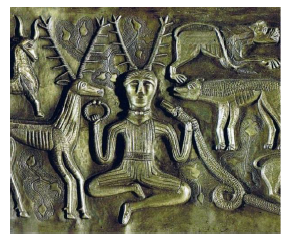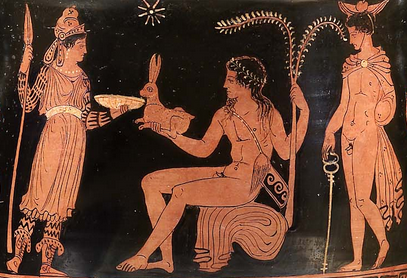Ancient Psychedelia: Alien Gods & Mushroom Goddesses
Online Book - Chapter 11, Page 193
Back to Online Book Mainpage / Next Page (Chapter 11, Page 194)
| Hades (Estruscan Aita, Roman Dis, Pluto), was a Greek god of the underworld, much like Osiris, and son to Kronos and Rhea. His brothers are Zeus and Poseidon. He was married to Persephone by abduction when she was out collecting the narcissus. In Homeric and Ionic Greek, he was known as Aides. Around the 5th century BC, the Greeks started referring to him as Pluto(n). (105) Hades, descends not from hell but from the “Green Man,” or from Gallic, Cernunnos, the “Wild Man” which many modern researchers are starting to see for who he really is, a shaman. For decades, scholars have insisted to us that this figure was a “king of the beasts,” or a wild man. Never giving the link that he represents the seer, the visionary, the mediator for the tribe, the middleman between the tribespeople and their gods. Cernunnos has at its roots the word cern, related to carn, meaning “horn” in Welsh. (106) A study of the cauldron depiction of Cernunnos on the Gundestrup Cauldron from Denmark (200BC -300AD) reveals important iconography (59b). There is a bull, a deer, what appears to be a lion and what appears to be a pig. The shaman is holding an object in each hand, in the left, what could be a diadem since it is circular in shape and a serpent in the right hand. With the lion, I think we are looking at a mane being similar to the hood of a cobra. This is the cap with the wheel spokes. The pig is a natural predator of mushrooms. The bull and the deer connections with psilocybin and A. muscaria, and the diadem in the left hand is the mushroom cap, the arm is the stem and the serpent in the left hand represents the mushroom as well. Not only that, but flower or mushroom shaped objects are sprouting out from the deer and shaman horns and they exist in the lower left and right quadrants as well.  (59b) Depiction of Cernunnos on the Gundestrup Cauldron, Denmark c. 200 BC -300 AD In another 1500 years or so, we would start to see the Siberian shaman emerging through the documenting of Western contact experiences in the 16th and 17th centuries. The tales of the Siberian shaman, ultimately link us to the “Green Man” who splintered off and became Hades, or “Satan,” an anagram of Santa. |
There was a Nekromanteion, an ancient Greek temple of necromancy dedicated to Hades and Persephone where oracles of the dead would be pronounced. Poseidon (Latin Neptune) was one of the early Greek gods tracing his lineage back to Mycenae-Crete. His name means “Lord of the Earth” or “Husband of the Earth.” Poseidon is a god of the seas, waters, earthquakes and horses. His animal symbol is the bull. And his staff, the trident has its own interesting origins that remain somewhat a “mystery.” (107) One of Poseidon’s epithets was the “earth-shaker.” His association as a deity associated with “earthquakes” may be a misappropriation by some scholars since thunder was said to make the earth shake, and the mushroom is a mighty force that can grow up through concrete and break it up, so I think this is what “earth-shaker” really applies to. Several deities in Hesiod’s Theogany are referred to by the same term. As Zeus’s brother, Poseidon carried the “trident,” and like Zeus’s thunderbolt and Hades helmet, was fashioned by the three one-eyed Cyclops according to the Greek poet Hesiod. We learned previously about Shiva’s trishula, which was in actuality, a thunderbolt. The trident is a Greek version of the trishula. Euadne was the daughter of Poseidon and the nymph Pitane. She had a son Iamos (Iamus) with the god Apollon but fearing retribution abandoned him in the countryside. As he lay in a patch of violets he was nursed on honey by the bees. He was later instructed by his father Apollon in the art of prophecy. (108) In Thrace, Bendis was considered the moon-goddess and her counterpart in Greece was Hecate and Artemis. She was a goddess of the night and the hunt. Bendis is featured on a pair of Greek vases, one of which shows her feet adored with mushroom caps (42h), compared with one in which they are removed (42i).  (42h) Thracian Bendis, Apulian red-figure bell krater Museum of Fine Arts, Boston c. 400-300 BC (105) Occidental Mythology, p. 301; https://en.wikipedia.org/wiki/Hades (106) MacCulloch, Religion of the Ancient Celts, p. 69 (107) Occidental Mythology, p. 54-55 (108) Apples of Apollo, p. 71-72; http://www.theoi.com/Heroine/Euadne.html |
Go Back to Page 192